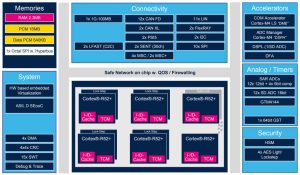 STMicroelectronics is aiming at electric vehicle drive-trains and domain-oriented systems with a group of microcontrollers announced today
STMicroelectronics is aiming at electric vehicle drive-trains and domain-oriented systems with a group of microcontrollers announced today
“The real-time ‘Stellar P6’ automotive microcontrollers integrate motion-control and energy-management domains with actuation capabilities” for software-defined drive-traction architectures,” said ST automotive v-p Luca Rodeschini. “As the automotive industry begins work on vehicle platforms for model-year 2024, ST is ready with the microcontrollers to support development.”
P6 MCUs will have up to six Arm Cortex R52 processor cores, some operating in lock-step and some in split-lock for fail-safe redundancy. Over-the-air updates are supported.
For safety and security, hardware virtualisation is provided to isolate the various software packages intended to run on the cores.
At the moment, two devices are proposed (samples are said to be available), both with six cores: SR6P6C4 in a 17 x 17 x 0.8mm FPBGA 292 package, and SR6P6C8 in 25 x 25 x 0.8 FPBGA 516.
Alongside these, two P7 processors have appeared in ST’s pipeline – in the same choice of packaging, each has six Cortex-R52+ cores, nearly four times the ram, and more non-volatile memory.
Manufactured in ST’s own 28nm FD-SOI technology, which offers some inherent protection against radiation, P6 devices have up to 20Mbyte of non-volatile phase-change memory – rather than flash. “Developed and tested according to automotive requirements for high-temperature operation, radiation hardening and data retention, ST’s phase-change memory also delivers faster access time through single-bit overwrite, a feature unavailable in flash,” said ST.
Over-the-air updates can be made without down-time, added ST, using a memory-saving mechanism that dynamically allocates space to the new software image until it is validated – while the rest of the memory continues to execute the current real-time application.
On-chip safety measures are aimed at ISO 26262 ASIL-D applications. These include a hardware security module, extended with cryptographic engines operating in lockstep, that also “enables enhanced Evita full security capability”, said ST, “and provides safe network authentication to protect manufacturer firmware as well as end-user data”.
Domain (or zone) architectures group the functions of multiple electronic control units into fewer control units. This can mean that software from multiple sources, not originally intended to be run alongside other software, need to be consolidation onto one processor.
